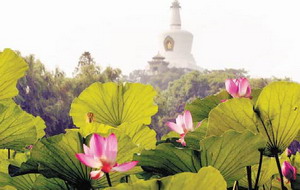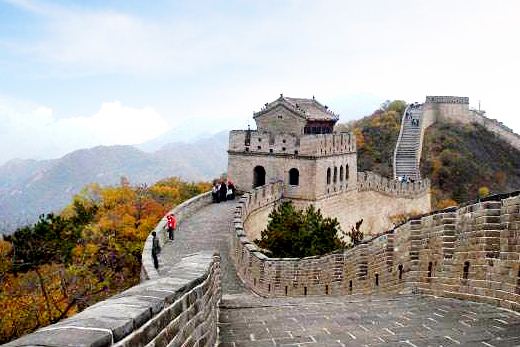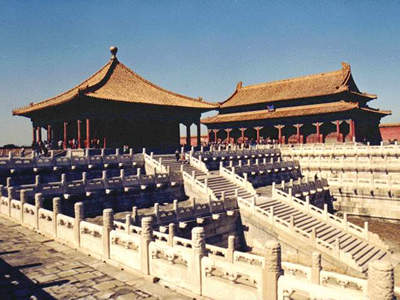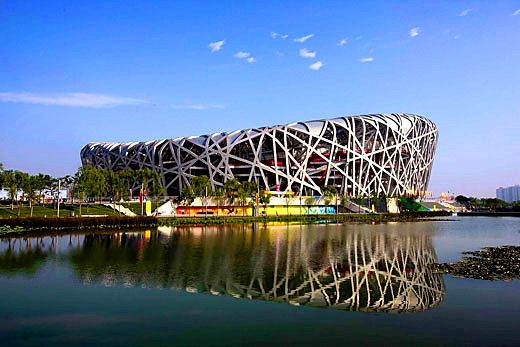
Below is a more detailed introduction of the better known structures in Beihai:
Qionghua (Jade) Islet, also known as Qiong Islet or Mountain, covers an area of some 66,000 square meters. Lamaist advisers proposed that Emperor Shunzhi of the Qing (reigned 1644-1661) build the 35-meter-tall onion-shaped dagoba on the site of the Jin Dynasty Palace of the Moon (Guanghandian). The White Dagoba was damaged in the 1976 Tangshan earthquake but repaired soon after. Large weirdly shaped rocks, carved to resemble caves inhabited by Daoist immortals, cover the island. At the summit stands an ancient hall, reputed to have been the dressing chamber of empress dowagers during the Liao Dynasty. On the slopes are the Hall of Correct Enlightenment (Zhengjuedian), the Hall of Universal Peace (Pu' andian) and the Hall of Beneficent Causation (Shanyindian).
The Hall of Beneficent Causation is built of glazed bricks with 100 glazed ceramic images of the Buddha set into its walls. In the center is a statue of the Goddess of Mercy with 1,000 Arms, also called the Buddha Who Calms the Lake (Zhenhaifo). The Pavilion for Evoking Victory (Yinshengting) which stands before the dagoba contains a stela inscribed with"A Complete Record of White Dagoba Hill."The Pavilion for Inspecting Old Script (Yuegulou) displays 495 samples of famous Chinese calligraphers, which were carved in stone during the time of Emperor Qianlong. The collection is an excellent source for rubbings.
The Temple of Eternal Peace (Yong' ansi), originally the home of the Lama Nuo Buhan, was built in 1651 and named the Temple of the White Dagoba. Inside the main gate lies the Hall of the Wheel of the Law (Falundian). Up the flight if stone steps is the Hall of Beneficent Causation.
The Hall of Heaven Kings (Tianwangdian) lies on the west bank of Beihai Lake. A glazed tile memorial archway stands before the hall, and to the north is the Gate of Heavenly Kings. Inside are two stone pillars, the eastern pillar inscribes with the Diamond Sutra ( Jingangjing ) and the western with the Yaoshi Classic . Behind the Hall of Great Compassion and Truth
(Dacizhenrudian) is the Ten Buddha Pagoda (Shifota). To the west of the pagoda is the Beihai Stadium, built after the founding of the People' s Republic. The Hall of Heavenly Kings is now the Beijing Youth Science and Technology Hall.
The Tranquil Heart Study (Jingxinzhai) lies to the east of the Hall of Heavenly Kings. The buildings of this famous "park within a park" are the best preserved in Beihai. After 1949, this section was entirely renovated for use by the Central Documentary History Research Institute.
The five Dragon Pavilions (Wulongting) to the west of the Hall of Heavenly Kings were built in the Ming Dynasty as a fishing spot for the emperors. The five pavilions on the water are linked by an angled corridor that resembles a swimming dragon' s Benevolence (Longzeting). It has a double-eaved roof which resembles a parasol and rectangular terraces extending front and back. To the east lie the Fragrance (Zixiang) and Auspicious Clarity (Chengxiang) pavilions, and to the west the Surging Good Fortune (Yongrui) and Floating Emerald (Fucui) pavilions.
The Nine-Dragon Wall (Jiulongbi) is to the south of the Beihai Stadium. Built in the Ming Dynasty, it is 6.9 meters high, 25.5 meters long, 1.4 meters thick, and constructed entirely of glazed tiles. On each side nine coiling dragons frolic among waves and clouds.
The Iron Screen (Tieyingbi) in front of the Hall of Gazing at the Water (Chengguantang) derives its name from its color, which resembles iron ore. The strange creatures carved on both sides date from the bell casting room at Deshengmen (Gate of Moral Victory), where it began to rust. In 1947 the Beiping Cultural Relics Administration brought it to Beihai for display.
The Bronze Immortal Bearing the Dew-Colleting Dish (Tongxianchenglupan) stands on the northwest slope of Qionghua Islet.
According to tradition, the Han Dynasty emperor Wu Di was told that by drinking dew caught in a bronze dish he could live to the age of eight hundred. This was so intriguing to the middle-aged emperor, in 104 BC he had a bronze immortal and dish cast and placed in a palace outside the capital Chang' an (now Xi' an). Qianlong shared his predecessor' s dreams of longevity and had another statue of the same image cast and placed on Qionghua Islet. Others say Jin rulers brought the statue here from the Song capital of Bianliang (now Kaifeng) when they built their palace.


 About Beijing
About Beijing 


